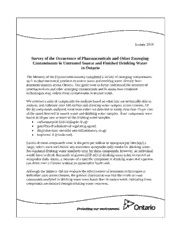
Summary : survey of the occurrence of pharmaceuticals and other emerging contaminants in untreated source and finished drinking water in Ontario PDF
Preview Summary : survey of the occurrence of pharmaceuticals and other emerging contaminants in untreated source and finished drinking water in Ontario
January 2010 Survey of the Occurrence of Pharmaceuticals and Other Emerging Contaminants in Untreated Source and Finished Drinking Water in Ontario The Ministry of the Environment recently completed a survey of emerging contaminants such as pharmaceutical products in source water and drinking water directly from treatment systems across Ontario. Our goals were to better understand the presence of pharmaceuticals and other emerging contaminants and to assess how treatment technologies may reduce these contaminants in treated water. We selected a suite of compounds for analysis based on what labs are technically able to analyze, and collected over 100 surface and drinking water samples across Ontario. Of the 46 compounds analyzed, most were either not detected or rarely (less than 10 per cent of the time) detected in source water and drinking water samples. Four compounds were found in 10 per cent or more of the drinking water samples: • carbamazepine (anti-epileptic drug) • gemfibrozil (cholesterol regulating agent) • ibuprofen (non steroidal anti-inflammatory drug) • bisphenol A (plasticizer). Levels of these compounds were in the parts per trillion or nanogram per litre (ng/L) range, which were well below any maximum acceptable daily intake for drinking water. No regulated drinking water standards exist for these compounds; however, an individual would have to drink thousands of glasses (250 ml) of drinking water a day to exceed an acceptable daily intake, a measure of a specific compound in drinking water that a person can drink over a lifetime without an appreciable health risk. Although the ministry did not evaluate the effectiveness of treatment technologies at individual sites across Ontario, the general observation was that the levels of most compounds analyzed in drinking water were lower than in source water, indicating these compounds are reduced through drinking water treatment. The ministry will continue its efforts to research and monitor pharmaceuticals and other contaminants of emerging concern in Ontario’s source and drinking waters. To read the full survey report go to: http://www.ene.gov.on.ca/publications/7269e.pdf
